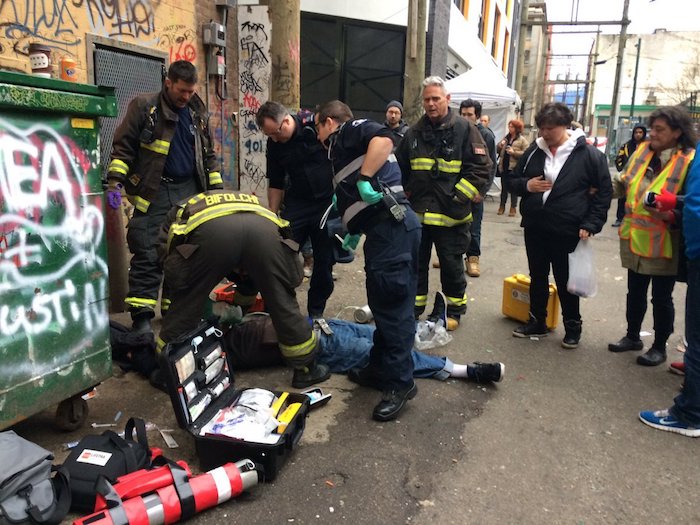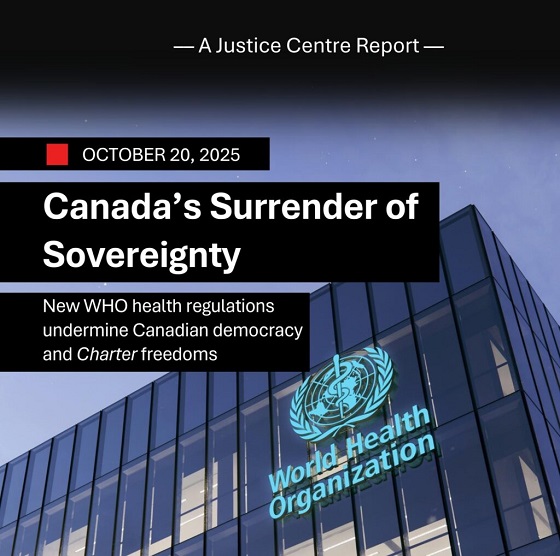Addictions
“Government Heroin” documentary exposes rampant safer supply fraud

By Adam Zivo
There is no substitute for hearing testimony with your own ears and eyes.
Although there is ample evidence that Canada’s “safer supply” programs are being widely defrauded and flooding communities with opioids, advocates continue to deny that this problem exists. That’s why I premiered my new documentary this week, “Government Heroin,” which follows the story of Callum Bagnall, a 25-year-old student who purchased thousands of diverted safer supply pills in London, Ontario.
While many written accounts of safer supply fraud have been published in the Canadian media, this documentary provides, for the first time, an extended interview with a former addict who openly describes his own use of these diverted drugs. It is one thing to read these stories, and altogether another to watch and listen to them – so perhaps this will help dispel the myths that have been pushed, rather aggressively, by the harm reduction movement.
In the film, Callum explains how, three years ago, a friend informed him that drug users in the city were receiving “insane” amounts of free safer supply drugs – predominantly hydromorphone, an opioid as potent as heroin. While these drugs are meant to wean addicts off riskier street substances, the friend explained that recipients mostly sell their safer supply at bargain prices so they can procure stronger substances, such as illicit fentanyl.
At first, Callum thought this was a joke. He had been struggling with a moderate addiction to pharmaceutical opioids – mostly oxycodone and Percocet – but, as these pills were expensive and hard to find, his drug use remained stable. The idea that the government was showering individuals with hundreds of powerful opioid pills a month, for free and with essentially no supervision, seemed “almost like a dream for a drug addict.”
But then he connected with some safer supply clients and realized that everything that he had heard was true. Fueled by a near-limitless supply of dirt-cheap opioids, Callum’s drug use rapidly spun out of control and, for two years, his life fell into utter disarray. Although he went to rehab last year, he says that his mind remains muddled by the aftereffects of these drugs to this day.
“I would have already been at the end of my road and (would) have gone to rehab at that point, if safer supply drugs weren’t so cheap and available. With the small amount of money I was making, I was able to afford hundreds of safer supply pills a week because of how cheap they were,” he says.
It was obvious to Callum that these pills were not counterfeit, given their quality and consistency and the fact that they typically came in their original, labelled prescription bottles: “Usually the people I was buying them from would try to scratch out the doctor’s name or their name. They were kind of paranoid about that. But sometimes they would just give it to me with the label unripped, not covered with marker or anything.”
Callum estimates that 90 percent of the safer supply clients he interacted with were diverting their drugs – a figure that is fairly consistent with estimates provided by former drug users I interviewed in London last year, who typically placed the diversion rate among their circles at around 80 percent.
Callum also believes that organized crime is involved in the trafficking of these drugs, and recalled how one higher-level dealer said that he would drive to northern Ontario, where safer supply is essentially unavailable, with thousands of pills stowed in his trunk to resell at a significant profit.
Subscribe for free to get BTN’s latest news and analysis, or donate to our journalism fund.
While I was unable to independently verify Callum’s claim about intraprovincial trafficking, his testimony is consistent with information provided to me earlier this year by Michael Tibollo, Ontario’s Associate Minister of Mental Health and Addictions, who said that, based on certain police reports and epidemiological data, it is clear that there is a particular problem with safer supply drugs being trafficked from London to northern Ontario.
Callum was able to corroborate the general contours of his story by providing dozens of screenshots of time-stamped text conversations between himself and his former dealers (some of which appear in the documentary), as well as excerpts of his medical records indicating that he had been diagnosed with severe opioid use disorder and had been “buying safer supply from friends.”
He also called a safer supply patient whom he used to purchase drugs from, and, while I listened in, had her confirm that she had hundreds of pills ready to sell and could introduce him to a safer supply doctor if he wanted to get on the program. A video recording of this conversation was originally meant to be included in the documentary, but was cut to mitigate risk of retaliation.
Finally, Callum’s mother, a registered nurse, appears in the documentary and recounts finding safer supply prescription bottles in her son’s room on the day he went to rehab.
As public scrutiny of safer supply has increased over the past year, providers have insisted that they are closely monitoring diversion through urine testing. Yet Callum says that the clients he interacted with would occasionally, in the process of selling their drugs, withhold a few of their pills and openly admit to him that they needed these small amounts to pass their tests.
“(They) would also take one or two pills the night before they get their prescription, so that it looks like it’s in their system. It shows up on the urine tests. So they would use that to pass the urine tests, so that they would get another script the next week,” he says in the film.
The exploitation of this loophole was confirmed by Dr. Janel Gracey, an addiction physician who treated Callum and who is also featured in my documentary. She says that “it is known in the addiction world that urine testing is not effective at catching diversion” because such tests only measure the presence of a drug, not its quantity. A safer supply patient can divert almost all of their drugs and still pass their urine tests, she says, so long as they take just one pill before giving their samples.
Gracey characterizes Canada’s current safer supply system as an underregulated “free for all” that destabilizes patients while allowing some pharmacists and physicians to reap considerable profits. “I know people on the safer supply program that have never even used fentanyl, and that’s the whole point of the program: to get them off the fentanyl. So they’re just lining up and getting a bunch of (hydromorphone), really, for no reason,” she says.
Gracey estimates that, of her 400 patients, approximately half have used, or know someone who has used, diverted safer supply drugs. She says that inexpensive hydromorphone is now “readily available on every street corner here in London,” and that dealers are “bombarding” her patients with the drug, causing many of them to “fall off the rails.”
“We are seeing younger and younger patients come in, unfortunately. Fifteen (and) 16-year-olds coming in, and they’re getting hooked on (hydromorphone) because it’s so incredibly cheap. It’s cheaper than alcohol,” she says. “We do get a few coming in that are there because of fentanyl use, but usually even the (young fentanyl users) started with (hydromorphone).”
I encourage you to watch “Government Heroin,” as the 19-minute documentary provides a more visceral and comprehensive account of the harms described here. There is no substitute for hearing testimony with your own ears and eyes.
This article was originally published in The Bureau, a Canadian media outlet that investigates the intersections of organized crime, drug trafficking and foreign interference.
Subscribe to Break The Needle. Our content is always free – but if you want to help us commission more high-quality journalism, consider getting a voluntary paid subscription.
Addictions
BC premier admits decriminalizing drugs was ‘not the right policy’

From LifeSiteNews
Premier David Eby acknowledged that British Columbia’s liberal policy on hard drugs ‘became was a permissive structure that … resulted in really unhappy consequences.’
The Premier of Canada’s most drug-permissive province admitted that allowing the decriminalization of hard drugs in British Columbia via a federal pilot program was a mistake.
Speaking at a luncheon organized by the Urban Development Institute last week in Vancouver, British Columbia, Premier David Eby said, “I was wrong … it was not the right policy.”
Eby said that allowing hard drug users not to be fined for possession was “not the right policy.
“What it became was a permissive structure that … resulted in really unhappy consequences,” he noted, as captured by Western Standard’s Jarryd Jäger.
LifeSiteNews reported that the British Columbia government decided to stop a so-called “safe supply” free drug program in light of a report revealing many of the hard drugs distributed via pharmacies were resold on the black market.
Last year, the Liberal government was forced to end a three-year drug decriminalizing experiment, the brainchild of former Prime Minister Justin Trudeau’s government, in British Columbia that allowed people to have small amounts of cocaine and other hard drugs. However, public complaints about social disorder went through the roof during the experiment.
This is not the first time that Eby has admitted he was wrong.
Trudeau’s loose drug initiatives were deemed such a disaster in British Columbia that Eby’s government asked Trudeau to re-criminalize narcotic use in public spaces, a request that was granted.
Records show that the Liberal government has spent approximately $820 million from 2017 to 2022 on its Canadian Drugs and Substances Strategy. However, even Canada’s own Department of Health in a 2023 report admitted that the Liberals’ drug program only had “minimal” results.
Official figures show that overdoses went up during the decriminalization trial, with 3,313 deaths over 15 months, compared with 2,843 in the same time frame before drugs were temporarily legalized.
Addictions
Canada must make public order a priority again

A Toronto park
Public disorder has cities crying out for help. The solution cannot simply be to expand our public institutions’ crisis services
[This editorial was originally published by Canadian Affairs and has been republished with permission]
This week, Canada’s largest public transit system, the Toronto Transit Commission, announced it would be stationing crisis worker teams directly on subway platforms to improve public safety.
Last week, Canada’s largest library, the Toronto Public Library, announced it would be increasing the number of branches that offer crisis and social support services. This builds on a 2023 pilot project between the library and Toronto’s Gerstein Crisis Centre to service people experiencing mental health, substance abuse and other issues.
The move “only made sense,” Amanda French, the manager of social development at Toronto Public Library, told CBC.
Does it, though?
Over the past decade, public institutions — our libraries, parks, transit systems, hospitals and city centres — have steadily increased the resources they devote to servicing the homeless, mentally ill and drug addicted. In many cases, this has come at the expense of serving the groups these spaces were intended to serve.
For some communities, it is all becoming too much.
Recently, some cities have taken the extraordinary step of calling states of emergency over the public disorder in their communities. This September, both Barrie, Ont. and Smithers, B.C. did so, citing the public disorder caused by open drug use, encampments, theft and violence.
In June, Williams Lake, B.C., did the same. It was planning to “bring in an 11 p.m. curfew and was exploring involuntary detention when the province directed an expert task force to enter the city,” The Globe and Mail reported last week.
These cries for help — which Canadian Affairs has also reported on in Toronto, Ottawa and Nanaimo — must be taken seriously. The solution cannot simply be more of the same — to further expand public institutions’ crisis services while neglecting their core purposes and clientele.
Canada must make public order a priority again.
Without public order, Canadians will increasingly cease to patronize the public institutions that make communities welcoming and vibrant. Businesses will increasingly close up shop in city centres. This will accelerate community decline, creating a vicious downward spiral.
We do not pretend to have the answers for how best to restore public order while also addressing the very real needs of individuals struggling with homelessness, mental illness and addiction.
But we can offer a few observations.
First, Canadians must be willing to critically examine our policies.
Harm-reduction policies — which correlate with the rise of public disorder — should be at the top of the list.
The aim of these policies is to reduce the harms associated with drug use, such as overdose or infection. They were intended to be introduced alongside investments in other social supports, such as recovery.
But unlike Portugal, which prioritized treatment alongside harm reduction, Canada failed to make these investments. For this and other reasons, many experts now say our harm-reduction policies are not working.
“Many of my addiction medicine colleagues have stopped prescribing ‘safe supply’ hydromorphone to their patients because of the high rates of diversion … and lack of efficacy in stabilizing the substance use disorder (sometimes worsening it),” Dr. Launette Rieb, a clinical associate professor at the University of British Columbia and addiction medicine specialist recently told Canadian Affairs.
Yet, despite such damning claims, some Canadians remain closed to the possibility that these policies may need to change. Worse, some foster a climate that penalizes dissent.
“Many doctors who initially supported ‘safe supply’ no longer provide it but do not wish to talk about it publicly for fear of reprisals,” Rieb said.
Second, Canadians must look abroad — well beyond the United States — for policy alternatives.
As The Globe and Mail reported in August, Canada and the U.S. have been far harder hit by the drug crisis than European countries.
The article points to a host of potential factors, spanning everything from doctors’ prescribing practices to drug trade flows to drug laws and enforcement.
For example, unlike Canada, most of Europe has not legalized cannabis, the article says. European countries also enforce their drug laws more rigorously.
“According to the UN, Europe arrests, prosecutes and convicts people for drug-related offences at a much higher rate than that of the Americas,” it says.
Addiction treatment rates also vary.
“According to the latest data from the UN, 28 per cent of people with drug use disorders in Europe received treatment. In contrast, only 9 per cent of those with drug use disorders in the Americas received treatment.”
And then there is harm reduction. No other country went “whole hog” on harm reduction the way Canada did, one professor told The Globe.
If we want public order, we should look to the countries that are orderly and identify what makes them different — in a good way.
There is no shame in copying good policies. There should be shame in sticking with failed ones due to ideology.
Our content is always free – but if you want to help us commission more high-quality journalism,
consider getting a voluntary paid subscription.
-

 MAiD11 hours ago
MAiD11 hours agoDisabled Canadians increasingly under pressure to opt for euthanasia during routine doctor visits
-

 Alberta13 hours ago
Alberta13 hours agoPetition threatens independent school funding in Alberta
-

 Alberta1 day ago
Alberta1 day agoBusting five myths about the Alberta oil sands
-

 Courageous Discourse1 day ago
Courageous Discourse1 day agoNo Exit Wound – EITHER there was a very public “miracle” OR Charlie Kirk’s murder is not as it appears
-

 Business2 days ago
Business2 days agoQuebecers want feds to focus on illegal gun smuggling not gun confiscation
-

 Business12 hours ago
Business12 hours agoCanada Revenue Agency found a way to hit “Worse Than Rock Bottom”
-

 Energy2 days ago
Energy2 days agoMinus Forty and the Myth of Easy Energy
-

 Health2 days ago
Health2 days agoNew report warns WHO health rules erode Canada’s democracy and Charter rights





